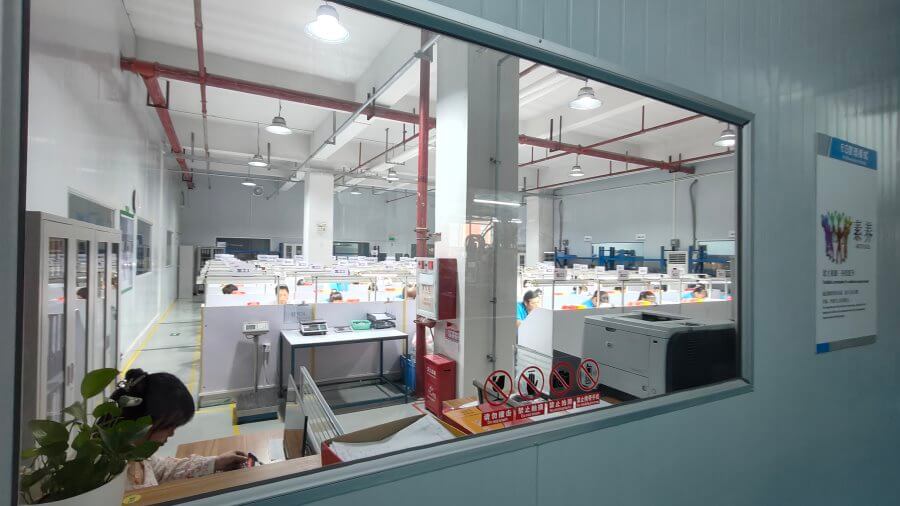Liquid Silicone Rubber (LSR), also known as liquid silicone or injection-molded liquid silicone, is a type of silicone that flows and exhibits a liquid-like form. LSR is a non-toxic, heat-resistant, highly resilient, and flexible thermosetting material with rheological behavior characterized by low viscosity, rapid curing, shear thinning, and a relatively high coefficient of thermal expansion. Technically, any silicone product that is liquid before curing and becomes an elastomer after curing can be referred to as LSR. However, the term typically refers to silicone used in liquid injection molding (LIM), with a shrinkage rate of ≤0.1%. This enables precision in replicating product dimensions, making it ideal for mass production of high-precision silicone components.
LSR is a two-component addition-cured liquid silicone elastomer that is produced using liquid injection molding in a 1:1 weight or volume ratio. It cures into an elastomer under various conditions, such as heating, and does not require specialized techniques or expensive equipment, making it suitable for automated molding systems. The cured elastomer offers superior properties, including non-toxicity, high transparency, temperature resistance, flame resistance, weather resistance, compression resistance, excellent insulation, and resistance to chemical corrosion.
Raw Materials of Liquid Silicone Rubber (LSR)
LSR is primarily composed of base gum (poly(methylvinyl)siloxane), crosslinkers (poly(methylhydrosiloxane)), catalysts like platinum complexes, and other fillers as needed. Depending on the intended application, additional fillers such as silica (produced via fumed or precipitated methods), iron oxide, titanium dioxide, and carbon black may be added. For manufacturing transparent LSR, silicone wax can also be included as a filler. LSR elastomers are formed through crosslinking between the Si-H groups in the crosslinker and the Si-CH=CH2 groups in the base gum.
1. Base Gum
The base gum of LSR is poly(methylvinyl)siloxane, which has a wide molecular weight distribution, typically ranging from a few thousand to 100,000–200,000. Low-molecular-weight components reduce viscosity, while high-molecular-weight components enhance strength. The vinyl content in the base gum must be controlled within a specific range to achieve desired properties in the cured product. Too little vinyl content results in poor crosslink density and elastomer performance, while excessive vinyl content leads to brittleness and reduced elongation or aging resistance.
2. Crosslinker
Poly(methylhydrosiloxane) serves as the crosslinker in LSR. Its active hydrogen atoms, directly bonded to silicon atoms, react with the vinyl groups in the base gum to facilitate curing. To achieve an optimal network structure in the elastomer, at least three or more Si-H groups per molecule are required. The ratio of Si-H groups in the crosslinker to vinyl groups in the base gum must be carefully balanced for optimal results.
3. Catalyst
Transition metal complexes, particularly those of platinum, are commonly used as catalysts in LSR. Homogeneous catalysts such as chloroplatinic acid complexes are widely employed for their high activity and selectivity. However, overly active catalysts can lead to rapid curing and reduced workability. Catalyst usage is typically controlled to a concentration range of 1 × 10⁻⁷ to 2 × 10⁻⁵ of the total weight of the base gum and crosslinker.
4. Inhibitor
Inhibitors are added to LSR to prevent premature curing during processing. These inhibitors interact with the platinum catalyst to delay the reaction until the desired curing temperature is reached. Common inhibitors include alkyne compounds, sulfur compounds, and organic peroxides.
5. Fillers
Reinforcing fillers, such as silica, significantly enhance the tensile strength of LSR. For applications requiring both high strength and excellent flowability, MQ-type silicone resins are used as fillers to improve physical properties without increasing viscosity.
6. Other Additives
Additional additives can improve the performance of LSR elastomers. For example, rare-earth or transition metal oxides can enhance heat resistance, while fillers like quartz powder improve flame retardancy. Titanium dioxide, iron oxide, and aluminum hydroxide can be added for coloration, while carbon black can be used to create semiconductive materials.
Molding Methods for Liquid Silicone Rubber (LSR)
Due to its liquid form, Liquid Silicone Rubber (LSR) requires Liquid Injection Molding (LIM) for production. The principle is similar to plastic injection molding, but since the raw material of LSR is in liquid form, the entire process must be carried out at low temperatures to prevent premature curing due to heat during injection, which could affect flowability. The final product is completed through heating in the mold.
The Liquid Injection Molding (LIM) Process
- Material Loading: The barrel of liquid silicone rubber is placed at the feed section of the machine.
- Mixing and Stirring: The A/B components are mixed in a 1:1 ratio through a static mixer.
- Injection Molding: The mixed liquid silicone rubber is injected into the mold cavity.
- Heating and Curing: The mold is heated to cure the liquid silicone rubber and form the product.
- Product Removal: The final product is removed.
Advantages of the Process:
- High Precision: All manual operations are replaced by automated machinery, resulting in high product accuracy.
- High Efficiency: The A/B components cure in a few seconds at the proper temperature, leading to a high output.
- Cost Reduction: LIM reduces the waste of labor, electricity, and materials, and is suitable for producing all products made with high-temperature adhesives.
Composition and Characteristics of Liquid Silicone Rubber (LSR) LSR consists of two parts of silicone, with viscosities ranging from 50,000 to over 1,000,000 cPs, mixed in a 1:1 ratio. It is typically cured using a platinum-catalyzed additive system at temperatures above 80°C. The composition includes:
- 75% linear silicone polymer
- 23% fumed silica (enhances physical properties)
- Curing additives (such as hydrogen crosslinkers and inhibitors)
This combination gives uncured LSR a creamy or Vaseline-like appearance, with medium-to-high viscosity, making it easy to handle. After curing, LSR exhibits excellent mechanical properties, including high transparency, high toughness, and outstanding tensile strength.
Curing and Mechanical Properties of Liquid Silicone Rubber The curing performance of LSR is influenced by various factors, such as the polymer’s molecular weight, filler type, and the interaction of the molecular structure. Most commercially available LSRs use platinum-catalyzed additives for the curing reaction, offering a hardness range from 0A to 90A (Shore hardness). The crosslinking density can be optimized by adjusting the ratio of vinyl and hydrogen groups to achieve the best performance.
In NuSil technology, the A component contains the platinum catalyst, while the B component contains the crosslinker and inhibitor. This design helps control the reaction speed, ensuring that the mixture has enough storage time before volatilization due to heating, improving processing stability and production efficiency.
Product Characteristics of Liquid Silicone Rubber (LSR)
Liquid silicone rubber is a robust and versatile type of silicone. It can be injection molded into nearly any shape while maintaining its elasticity and resistance to tearing, enabling the production of items ranging from O-rings to thin-walled products of various shapes. LSR can be crystal-clear and manufactured for products with unique properties, such as solvent resistance, high heat stability, or low outgassing.
Additionally, LSR can mix well with additives, special fillers (like pigments), and active pharmaceutical ingredients (APIs), with minimal impact on the key properties of the final cured elastomer, such as toughness and elasticity.
Liquid silicone rubber exhibits excellent transparency, tear resistance, resilience, anti-yellowing properties, thermal stability, water resistance, breathability, resistance to heat aging, and weather resistance. It also has superior thermal stability, cold resistance, outstanding electrical insulation properties, and does not produce toxic substances when burned. Silicone rubber is widely used in harsh environments due to its natural thermal stability in extreme temperatures and its ability to release stress in environments with alternating heat and cold, thanks to its low modulus.
In the healthcare industry, LSR is well-known for its biocompatibility, with a long history of use in implantable medical devices.
Advantages of Liquid Silicone Rubber (LSR) Products
- Wide Temperature Range: LSR can withstand temperatures from -50℃ to 250℃.
- Weather and UV Stability: LSR remains stable under all weather conditions and UV exposure, with excellent aging resistance.
- High Insulation: Dielectric strength ≥ 20kV/mm.
- Fast Curing Speed: Approximately 10 times faster than conventional solid silicone.
- High Tear Strength and Elongation: Exceptional toughness and flexibility.
- Crystal Clear Transparency: Can include fillers and additives to modify chemical properties.
- Long Standby in Cold Environments: Can remain in the barrel for extended periods at low temperatures.
- Low Vulcanization Temperature: Short molding cycles reduce production costs.
- No By-Products During Curing: No need for secondary curing but allows for post-curing if required.
- Injection Molding Process: Accurate metering and minimal material waste.
- High Precision: Suitable for processing complex shapes with high accuracy.
- Good Bonding with Various Materials: Compatible with PA, PA6, PA66, PBT, PC, PPS, and more.
- Designed for High-Throughput and Precision Applications: Ideal for demanding manufacturing environments.
- Outstanding Product Features: LSR products offer excellent aging resistance, weather resistance, non-toxicity, high transparency, superior mechanical strength, and good elasticity.
Types of Liquid Silicone Rubber (LSR)
The hardness of liquid silicone rubber raw materials ranges from 0° LSR, 5° LSR, 10° LSR, 15° LSR, 20° LSR, 25° LSR, 30° LSR, 40° LSR, 50° LSR, 60° LSR, to 80° LSR. The applications of liquid silicone rubber include medical-grade LSR, nipple LSR, injection molding LSR, high-pressure resistant LSR, low-pressure low-viscosity LSR, conductive LSR, LSR for rubber rollers, fluorinated LSR, keypad-specific LSR, low-hardness LSR, high-transparency low-viscosity LSR, high-thermal conductivity silicone potting adhesive, high-resilience shock absorption LSR, diving mask-specific LSR, high-tensile strength LSR, food-grade odorless LSR, LSR for logos, LSR for textile surface printing or coating, LSR for cable accessories, LSR for gasket seals, LSR for phone cases, and LSR for watch straps.
Applications of Liquid Silicone Rubber (LSR)
-
Food Contact Applications
Examples: Beverage transport tubes, food-grade silicone tubes, drinking water silicone tubes, baby bottle caps, various miscellaneous items, components, calendering sheets, calendering tapes, and conveyor belts.
-
Pharmaceutical Applications
Examples: Liquid and soluble drug circulation tubes, medical-grade conveyor belts, etc.
-
Medical Applications
Examples: Short-term human contact products, such as various types of drainage tubes, urinary catheters, dialysis tubes, medical silicone suction balls, medical silicone vacuum drainage balls, medical-grade contrast agent silicone tubes, medical-grade silicone breathing tubes, medical-grade silicone balloon urinary catheters, tear drainage silicone tubes, silicone drainage tubes, silicone nasal oxygen Y-shaped tubes, disposable cervical dilator silicone catheters, postpartum hemostatic silicone balloons, medical anesthetic silicone masks, etc. Medical devices include pump tubes for artificial heart-lung machines, membrane artificial lungs, and drug delivery systems. Additionally, external circulation tubes, oxygen delivery tubes, syringe seals, and respiratory masks.
-
Human Implants
Examples: Long-term implant products such as artificial heart valves, artificial meninges, artificial breasts, artificial joints, hydrocephalus drainage devices, and various cosmetic and reconstructive implants.





